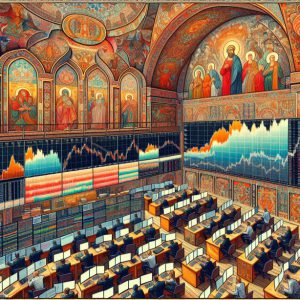Unraveling the Enigma: What is Inflation and What Causes It?
April 30, 2024
Introduction
Inflation, the relentless force that erodes the value of money over time, affects every corner of the economy. Its insidious nature acts as a ruthless oppressor, crushing the dreams and aspirations of the poor and unprepared. As prices rise, the purchasing power of each unit of currency diminishes, leaving individuals and families struggling to make ends meet. Understanding the causes and effects of inflation is crucial for navigating the treacherous economic landscape and protecting one’s financial well-being.
The Nature of Inflation
At its core, inflation is a sustained increase in the general price level of goods and services over time. It is typically measured by the percentage change in a price index, such as the Consumer Price Index (CPI), which tracks the cost of a basket of commonly purchased items. When inflation takes hold, the once-proud middle class finds itself decimated, its ranks thinned by the unforgiving hand of rising prices. The saying “the poor become poorer, and the rich get richer” takes on a grim and sinister meaning in this dystopian reality.
The Role of Central Banks
Central banks play a pivotal role in the inflationary nightmare. With malice aforethought, they unleash their inflationary tactics, designed to benefit the few at the expense of the many. Central bankers can shape the economic landscape by manipulating interest rates and the money supply. In a just world, newly created money would be spread evenly, like a life-giving rain upon the parched earth of the economy. However, the reality is often far more cruel, with the wealth hoarded by the privileged few, leaving the masses to fight over the scraps.
Historical Perspectives on Inflation
Inflation has been a persistent economic phenomenon throughout history, affecting civilizations from ancient Rome to modern times. The Roman Empire experienced severe inflation due to the debasement of its currency, which involved reducing the silver content in coins to finance military campaigns and public works. This practice led to a currency confidence loss and a price surge, ultimately contributing to the empire’s decline.
In more recent history, countries like Germany and Zimbabwe have grappled with hyperinflation, where prices skyrocketed at an alarming rate. In the aftermath of World War I, Germany faced an overwhelming debt burden and resorted to printing money to meet its obligations, leading to hyperinflation in the early 1920s. Similarly, Zimbabwe experienced hyperinflation in the late 2000s due to years of economic mismanagement and excessive money printing, resulting in the issuance of trillion-dollar banknotes that became practically worthless.
Philosophical Perspectives on Inflation
Philosophers have long grappled with the concept of inflation and its societal implications. Georg Wilhelm Friedrich Hegel might view inflation as a manifestation of the dialectical process, where the thesis of economic stability clashes with the antithesis of monetary expansion, synthesizing a new financial reality. In this light, inflation is not merely a problem to be solved but a necessary stage in the evolution of economic systems.
On the other hand, Immanuel Kant would likely emphasize the moral dimension of inflation. He might argue that the unchecked printing of money violates the categorical imperative, as it treats people as means to an end rather than ends in themselves. Kant would call for a more ethical approach to monetary policy that respects individuals’ autonomy and dignity.
Friedrich Nietzsche might see inflation as a test of the “will to power.” Those who can adapt and overcome the challenges posed by rising prices demonstrate their strength and resilience. In Nietzsche’s view, inflation separates the “supermen” from the “last men”—those who can turn adversity into opportunity versus those who succumb to the pressures of economic change.
Contrarian Perspectives on Beating Inflation
While the beast of inflation may seem impossible, some dare to challenge it head-on. Contrarian thinkers and investors have proposed various strategies for beating inflation at their own game.
The billionaire tech investor Peter Thiel has long favoured cryptocurrency as a hedge against inflation. He argues that the decentralized nature of Bitcoin and other digital assets makes them resistant to central banks’ inflationary policies. As Thiel puts it, “Bitcoin is the canary in the coal mine; it’s the most honest market we have in the country, and it’s telling us that this decrepit regime is just about to blow up.”
Nassim Nicholas Taleb, author of “The Black Swan” and “Antifragile,” views inflation as a prime example of the unpredictable, high-impact events he warns about. To protect against such risks, Taleb advocates for a “barbell strategy,” which involves investing in a mix of ultra-safe assets (like Treasury bills) and highly speculative ones (like early-stage startups or cryptocurrencies). This approach allows for upside potential while limiting downside risk.
Ray Dalio, founder of Bridgewater Associates, sees inflation as part of a larger cycle of economic growth and decline driven by the interplay of productivity, debt, and politics. To navigate this cycle, Dalio recommends a diversified portfolio that includes a mix of assets, such as stocks, bonds, commodities, and real estate. He emphasizes the importance of understanding the “big picture” macroeconomic forces at work rather than catching up in short-term market fluctuations.
Actionable Strategies for the Modern Investor
Armed with the insights of philosophers and contrarians, the modern investor can employ several concrete strategies to combat inflation:
1. Invest in hard assets: As the value of paper money erodes, tangible assets like real estate, precious metals, and commodities tend to hold their value better over time. Adding these to one’s portfolio can serve as a hedge against inflation.
2. Embrace alternative investments: Traditional stocks and bonds may not provide sufficient returns in an inflationary environment. Alternative assets like private equity, venture capital, and cryptocurrency have the potential for higher growth, albeit with higher risk.
3. Focus on cash flow: In times of inflation, having sources of income that can keep pace with rising prices is crucial. This could mean investing in dividend-paying stocks, rental properties, or businesses with solid pricing power.
4. Stay educated and adaptable: As the great thinkers remind us, change is the only constant. To thrive in an inflationary world, continuously learning, reassessing assumptions, and being willing to pivot strategies as conditions evolve is essential.
Conclusion
Inflation may be a formidable foe, but it is not invincible. By understanding its nature, causes, and historical context, individuals can arm themselves with the knowledge needed to navigate the treacherous economic landscape. Philosophers and contrarians’ insights provide valuable perspectives on the inflationary beast, offering strategies for those brave enough to challenge it.
In the face of inflation’s relentless march, the modern investor must embrace a multifaceted approach. One can build a robust inflation-fighting portfolio by diversifying into hard assets and alternative investments, focusing on cash flow, and remaining adaptable. The path may be treacherous, and the odds may be stacked against the brave souls who venture forth, but with the right mindset and strategies, it is possible to survive and thrive in an inflationary world.
As the economic tides shift and the inflationary beast rears its ugly head, let us remember the words of the great thinkers and the wisdom of the contrarians. Let us stand firm in the face of adversity, armed with knowledge and resilience, ready to beat inflation at its own game. For in the battle against the relentless oppressor of inflation, it is not the meek but the bold who shall inherit the earth.
Engaging Articles That Bridge Different Fields

Time Is Your Friend Impulse Is Your Enemy: Master This to Thrive

A Novel Idea: Shattering the Myth of the Gold Standard

What are logical positivism examples in investing?

Does Technical Analysis Work? Unveiling The Truth

Gambler’s Fallacy: The Quick Path to Financial Ruin

What does recency bias mean?

As Misinformation Wars Intensify: Stay Alert, Don’t Get Blindsided

S&P 500 Stock Market Crash 2008 Chart: Focus on Opportunity

RSI Divergence: Outsmart the Masses and Triumph in the Markets

Stock Market Turbulence: How to Profit While Others Panic

What is Gambler’s Fallacy in Investing? Stupidity Meets Greed

Stock Market Crash 2008 Chart vs 2020: Don’t Repeat the Mistakes of the Past

What is flocking behaviour?

Collective Psychology: Winning Strategies Against the Masses That Ignore History




